Petrography of Ophiolitic Detritus from a Miocene Conglomerate Formation on Darnó Hill, SW Bükk Mts (N Hungary): A Unique Tool to Trace Covered Ophiolitic Sequences
Abstract
:1. Introduction
2. Geological Background
3. Materials and Methods
4. Results
4.1. General Petrographic Description
4.2. Description of the Detrital Rock Types
4.2.1. Magmatic–Metamagmatic Rocks
- Hyalinic basalt
- Spherulitic basalt
- Variolitic basalt
- Intersertal and intervariolitic basalt
- Intergranular basalt
- Subophitic-ophitic basalt, dolerite, microgabbro
- Serpentinite
4.2.2. Sedimentary–Metasedimentary Rocks
- Siliciclastic rocks
- Radiolarite
- Calcareous grains
4.3. Quantitative Analysis of Detrital Grains
5. Discussion
| Inner Pillow Rock Types | Grain No. | Grain (Volume) Percent | Volume in d = 70 cm Pillow | Thickness in Pillow | |||
|---|---|---|---|---|---|---|---|
| This Work | Marescotti | This Work | Marescotti | ||||
| Piece | % | cm3 | cm | cm | cm | cm | |
| Hyalinic basalt | 44 | 10.7 | 19,207 | 1.3 | 0.9–1.5 | 1.3 | 0.9–1.5 |
| Spherulitic basalt | 51 | 12.4 | 22,258 | 1.6 | 1.4–2.0 | 1.6 | 1.4–2.0 |
| Variolitic basalt | 153 | 37.1 | 66,596 | 6.4 | 4.0–5.4 | 6.4 | 4.0–5.4 |
| Intersertal basalt | 113 | 27.4 | 49,184 | 8.2 | 15.5–17.1 | 25.7 | 25.7–29.1 |
| Intergranular basalt | 51 | 12.4 | 22,258 | 17.5 | 10.2–12.0 | ||
6. Conclusions
Funding
Data Availability Statement
Acknowledgments
Conflicts of Interest
References
- Haughton, P.D.W.; Todd, S.P.; Morton, A.C. Sedimentary provenance studies. Publ. Geol. Soc. Lond. Spec. Publ. 1991, 57, 1–11. [Google Scholar] [CrossRef]
- Garzanti, E. From static to dynamic provenance analysis—Sedimentary petrology upgraded. Sediment. Geol. 2016, 336, 3–13. [Google Scholar] [CrossRef]
- Gómez-Gras, D.; Roigé, M. Provenance Analysis of Clastics Applied to Sedimentary Geology and Petrology. A Special Issue of Minerals. 2022. Available online: https://www.mdpi.com/journal/minerals/special_issues/pacasgp (accessed on 5 July 2024).
- Wang, Y.; Deng, C.; Ding, Z.; He, F.; Feng, X.; Wang, D.; Hu, Q.; Zhao, X. Research on Sandstone Damage Characteristics and Acoustic Emission Precursor Features under Cyclic Loading and Unloading Paths. Sustainability 2022, 14, 12024. [Google Scholar] [CrossRef]
- Singhal, A.; Goel, S.; Sengupta, D. Physicochemical and elemental analyses of sandstone quarrying wastes to assess their impact on soil properties. J. Environ. Manag. 2020, 271, 111011. [Google Scholar] [CrossRef] [PubMed]
- Mange, M.A.; Wright, D.T. 2007: Heavy Minerals in Use, 1st ed.; Developments in Sedimentology Book Series; Elsevier: Amsterdam, The Netherland, 2007; Volume 58, p. 1283. ISBN 9780080548593. [Google Scholar]
- Hurst, A.; Morton, A.C. Provenance models: The role of sandstone mineral-chemical stratigraphy. Geol. Soc. Lond. Spec. Publ. 2014, 386, 7–26. [Google Scholar] [CrossRef]
- Bela, V.A.; Bessa, A.Z.E.; Armstrong-Altrin, J.S.; Kamani, F.A.; Nya, E.D.B.; Ngueutchoua, G. Provenance of clastic sediments: A case study from Cameroon, Central Africa. Solid Earth Sci. 2023, 8, 105–122. [Google Scholar] [CrossRef]
- Haas, J.; Budai, T.; Csontos, L.; Fodor, L.; Konrád, G.; Koroknai, B. (Eds.) Geology of the Pre-Cenozoic Basement of Hungary; Explanatory Notes for “Pre-Cenozoic Geological Map of Hungary” (1:500,000); Geological and Geophysical Institute of Hungary: Budapest, Hungary, 2014. [Google Scholar]
- Haas, J.; Kovács, S. The Dinaric-Alpine connection—As seen from Hungary. Acta Geol. Hung. 2001, 44, 345–362. [Google Scholar]
- Dimitrijević, M.N.; Dimitrijević, M.D.; Karamata, S.; Sudar, M.; Gerzina, N.; Kovács, S.; Dosztály, L.; Gulácsi, Z.; Less, G.; Pelikán, P. Olistostrome/mélanges—An overview of the problems and preliminary comparison of such formations in Yugoslavia and NE Hungary. Slovak Geol. Mag. 2003, 9, 3–21. [Google Scholar]
- Kovács, S.; Haas, J.; Ozsvárt, P.; Palinkaš, L.A.; Kiss, G.; Molnár, F.; Józsa, S.; Kövér, S. Reevaluation of the Mesozoic complexes of Darnó Hill (NE Hungary) and comparisons with Neotethyan accretionary complexes of the Dinarides and Hellenides—Preliminary data. Cent. Eur. Geol. 2010, 53, 205–231. [Google Scholar] [CrossRef]
- Kiss, G.; Molnár, F.; Palinkaš, L.A.; Kovács, S.; Hrvatović, H. Correlation of Triassic advanced rifting related Neotethyan submarine basaltic volcanism of the Darnó Unit (NE Hungary) with some Dinaridic and Hellenidic occurrences on the basis of volcanological, fluid-rock interaction and geochemical characteristics. Int. J. Earth Sci. 2012, 101, 1503–1521. [Google Scholar] [CrossRef]
- Kázmér, M.; Kovács, S. Permian–Palaeogene palaeogeography along the eastern part of the Insubric-Periadriatic lineament system: Evidence for continental escape of the Bakony–Drauzug unit. Acta Geol. Hung. 1985, 28, 71–84. [Google Scholar]
- Csontos, L.; Nagymarosy, A.; Horváth, F.; Kováč, M. Tertiary evolution of the intracarpathian area: A model. Tectonophysics 1992, 208, 221–241. [Google Scholar] [CrossRef]
- Csontos, L. Tertiary tectonic evolution of the Intra-Carpathian area: A review. Acta Vulcanol. 1995, 7, 1–13. [Google Scholar]
- Csontos, L.; Nagymarosy, A. The Mid-Hungarian line: A zone of repeated tectonic inversion. Tectonophysics 1998, 297, 51–72. [Google Scholar] [CrossRef]
- Channel, J.E.T.; Horváth, F. The African (Adriatic) Promontory as a paleogeographical premise for Alpine orogeny and plate movements in the Carpatho-Balkan Region. Tectonophysics 1976, 35, 71–101. [Google Scholar] [CrossRef]
- Sztanó, O.; Józsa, S. Interaction of basin margin faults and tidal currents on fan-delta-lobe architecture and composition: A case study from the early Miocene, Northern Hungary. Tectonophysics 1996, 266, 319–341. [Google Scholar] [CrossRef]
- Csontos, L. Structural outline of the Bükk Mts (N Hungary). Földtani Közlöny (Bull. Hung. Geol. Soc.) 1999, 129, 611–651, (In Hungarian with English Abstract). [Google Scholar]
- Csontos, L. Stratigraphic reevaluation of the Bükk Mts (N Hungary). Földtani Közlöny (Bull. Hung. Geol. Soc.) 2000, 130, 95–131, (In Hungarian with English Abstract). [Google Scholar]
- Plašienka, D. Continuity and episodicity in the early Alpine tectonic evolution of the Western Carpathians: How large-scale processes are expressed by the orogenic architecture and rock record data. Tectonics 2018, 37, 2029–2079. [Google Scholar] [CrossRef]
- Forián-Szabó, M.; Csontos, L. Tectonic structure of the Kis-fennsík area (Bükk mountains, NE Hungary). Geol. Carpathica 2002, 53, 223–234. [Google Scholar]
- Velledits, F.; Forián-Szabó, M.; Bérczi-Makk, A.; Piros, O.; Józsa, S. Stratigraphy and origin of the Kis Fennsík nappe (Bükk mountains, NE Hungary). Is the Silica unit really present in the Bükk mountains? Geol. Carpathica 2003, 54, 189–198. [Google Scholar]
- Fodor, L.; Radócz, G.; Sztanó, O.; Koroknai, B.; Csontos, L.; Harangi, S. Post-Conference Excursion: Tectonics, Sedimentation and Magmatism along the Darnó Zone. Geolines 2005, 19, 141–164. [Google Scholar]
- Petrik, A.; Beke, B.; Fodor, L.; Lukács, R. Cenozoic structural evolution of the southwestern Bükk Mts. and the southern part of the Darnó Deformation Belt (NE Hungary). Geol. Carp. 2016, 67, 83–104. [Google Scholar] [CrossRef]
- Szalay, I.; Zelenka, T. A Darnó-vonal jelentősége Észak-Magyarország szerkezeti fejlődésében. Általános Földtani Szemle (Gen. Geol. Rev.) 1979, 13, 7–31. [Google Scholar]
- Zelenka, T.; Baksa, C.; Balla, Z.; Földessy, J.; Földessyné Jarányi, K. Mezozóos ősföldrajzi határ-e a Darnó-vonal? Földtani Közlöny (Bull. Hung. Geol. Soc.) 1983, 113, 27–37. [Google Scholar]
- Zelenka, T.; Baksa, C.; Balla, Z.; Földessy, J.; Földessy-Járányi, K. The role of the Darnó Line in the basement structure of Northeastern Hungary. Geol. Zb.—Geol. Carpathica 1983, 34, 53–69. [Google Scholar]
- Fodor, L.; Sztanó, O.; Csontos, L.; Józsa, S.; Nagymarosy, A. A Darnó Övezet Tektonikai és Szedimentológiai Kutatása a Darnó Hegy és az Upponyi Hegység Környékén—Manuscript. The State Geological, Geophysical and Mining Data Store (MÁFI repository): Budapest, Hungary, 1992; 52p. [Google Scholar]
- Sztanó, O.; Tari, G. Early Miocene basin evolution in Northern Hungary—Tectonics and eustasy. Tectonophysics 1993, 226, 485–502. [Google Scholar]
- Veres, Z.; Varga, A. Karbonátos konkréciók az alsó-miocén Pétervásárai Homokkő Formációban (Pétervásárai-dombság, Leleszi-völgy): Genetikai megfontolások morfológiai és petrográfiai vizsgálatok eredményei alapján (Carbonate concretions in the Lower Miocene Pétervására Sandstone Formation (Pétervására Hills, Lelesz Valley): Genetic considerations based on morphological and petrographic investigations). Földtani Közlöny 2020, 150, 429–448, (In Hungarian with English Abstract). [Google Scholar]
- Babinszki, E.; Piros, O.; Csillag, G.; Fodor, L.; Gyalog, L.; Kercsmár, Z.; Less, G.; Lukács, R.; Sebe, K.; Selmeczi, I.; et al. (Eds.) Magyarország Litosztratigráfiai Egységeinek Leírása II. Kainozoos Képződmények (Description of Lithostratigraphic Units of Hungary II. Cenosoic Formations, in Hungarian); Authority for the Supervision of Regulated Activities: Budapest, Hungary, 2023; ISBN 978-963-671-329-4. Available online: https://sztfh.hu/downloads/foldtan/kainozoos_online.pdf (accessed on 7 July 2024).
- Kiss, J. Ércföldtani vizsgálatok a siroki Darnó-hegyen. Földtani Közlöny (Bull. Hung. Geol. Soc.) 1958, 88, 27–41. [Google Scholar]
- Kiss, G.; Molnár, F.; Palinkaš, L.A. Volcanic facies and hydrothermal processes in Triassic pillow basalts from the Darnó Unit, NE Hungary. Geol. Croat. 2008, 61, 385–394. [Google Scholar] [CrossRef]
- Kiss, G.; Molnár, F.; Palinkaš, L.A.; Kovács†, S. Field characteristics and petrography of the advanced rifting-related Triassic submarine basaltic blocks in the Jurassic mélange of the Darnó Unit. Cent. Eur. Geol. 2010, 53, 181–204. [Google Scholar] [CrossRef]
- Kiss, G.; Molnár, F.; Koller, F.; Péntek, A. Triassic advanced rifting related and Jurassic ophiolite-like magmatic rocks in the Bükk unit, NE-Hungary—An overview. Mitt. Österr. Miner. Ges. 2011, 157, 43–69. [Google Scholar]
- Beke, B. A Deformációs Szalagok Szerepe a Kainozoos Porózus Üledékek Szerkezetfejlődésében Észak-Magyarországon. Ph.D. Thesis, ELTE, Budapest, Hungary, 2016; p. 148. [Google Scholar]
- Bérczi, S.; Gadányi, P.; Gucsik, A.; Földi, T. Planetary Analog Studies and Simulations: Materials, Terrains, Morphologies, Processes. Eötvös Loránd University, Cosmic Matter Space Research Group: Budapest, Hungary, 2005; ISBN 963 00 6314 XÖ, 963 86873 2 0. [Google Scholar] [CrossRef]
- Kiss, J. A darnó hegyi neogén üledékkőzettani vizsgálata. Földtani Közlöny (Bull. Hung. Geol. Soc.) 1958, 88, 210–214. [Google Scholar]
- Balla, Z.; Szabó, I.; Földessy, J.; Havas, L.; Baksa, C. Mezozóos óceáni litoszféra-maradványok a Bükk-hegység délnyugati részén (Mezozoic oceanic lithosphere remnants in the southwestern part of the Bükk mountains (North Hungary), in Hungarian with english abstract). Általános Földtani Szemle (Gen. Geol. Rev.) 1981, 16, 35–87. [Google Scholar]
- Józsa, S. A Darnó-Hegyi Óceánaljzati Magmás Kőzetek Petrológiai–Geokémiai Vizsgálata. (Petrological and Geochemical Study of the Darnó Hill Ocean Floor Magmatic Rocks. In Hungarian). Ph.D. Thesis, Department of Petrology and Geochemistry, ELTE University, Budapest, Hungary, 1999; p. 172. [Google Scholar]
- Kiss, G.B.; Oláh, E.; Zaccarini, F.; Szakáll, S. Neotethyan rifting-related ore occurrences: Study of an accretionary mélange complex (Darnó Unit, NE Hungary). Geol. Carp. 2016, 67, 105–115. [Google Scholar] [CrossRef]
- Földessy, J. Petrological study of a diabase-spilite magmatic rock suite, Darnó-hegy, (Sirok, Hungary). Proc. Xth Congress CBGA 1975, 55–64. [Google Scholar]
- Kovács, S.; Haas, J.; Szebényi, G.; Gulácsi, Z.; Józsa, S.; Pelikán, P.; Bagoly-Árgyelan, G.; Görög, Á.; Ozsvárt, P.; Gecse, Z.; et al. Permo-mesozoic formations of the Recsk-Darnó Hill area: Stratigraphy and structure of the pre-tertiary basement of the Paleogene Recsk ore-field. Recsk and Lahóca geology of the paleogene ore complex, geosciences. Publ. Univ. Miskolc Ser. A Min. 2008, 73, 33–56. [Google Scholar]
- Kiss, G.B.; Zaccarini, F. Development of framboidal pyrite in the Upper Permian marly limestone of the NE-Hungarian Darnó Hill. Geol. Croat. 2013, 66, 233–244. [Google Scholar] [CrossRef]
- Balla, Z.; Baksa, C.; Földessy, J.; Havas, L.; Szabó, I. The tectonic setting of the ophiolites in the Bükk Mountains (North Hungary). Geol. Carpathica 1980, 31, 465–493. [Google Scholar]
- Scott, R.B.; Hajash, A., Jr. Initial submarine alteration of basaltic pillow lavas: A microprobe study. Am. J. Sci. 1976, 276, 480–501. [Google Scholar] [CrossRef]
- Kirkpatrick, R.J. Processes of crystallization in pillow basalts, Hole 396B, DSDP Leg 46. In San Juan, Puerto Rico to Las Palmas, Canary Islands, January–March 1975; Dmitriev, L., Heirtzler, J., Aguilar, R., Cambon, P., Dick, H.J.B., Dungan, M., Erickson, A., Hodges, F.N., Honnorez, J., Eds.; Texas A & M University, Ocean Drilling Program: College Station, TX, USA, 19 March 1979; Volume 46, pp. 271–282. [Google Scholar] [CrossRef]
- Marescotti, P.; Vanko, D.A.; Cabella, R. From oxidizing to reducing alteration: Mineralogical variations in pillow basalts from the east flank, Juan de Fuca Ridge. Proc. Ocean. Drill. Program Sci. Results 2000, 168, 119–136. [Google Scholar] [CrossRef]
- Jafri, S.H.; Charan, S.N. Quench textures in pillow basalt from the Andaman-Nicobar Islands, Bay of Bengal, India. Proc. Indian Acad. Sci. (Earth Planet. Sci.) 1992, 101, 99–107. [Google Scholar] [CrossRef]
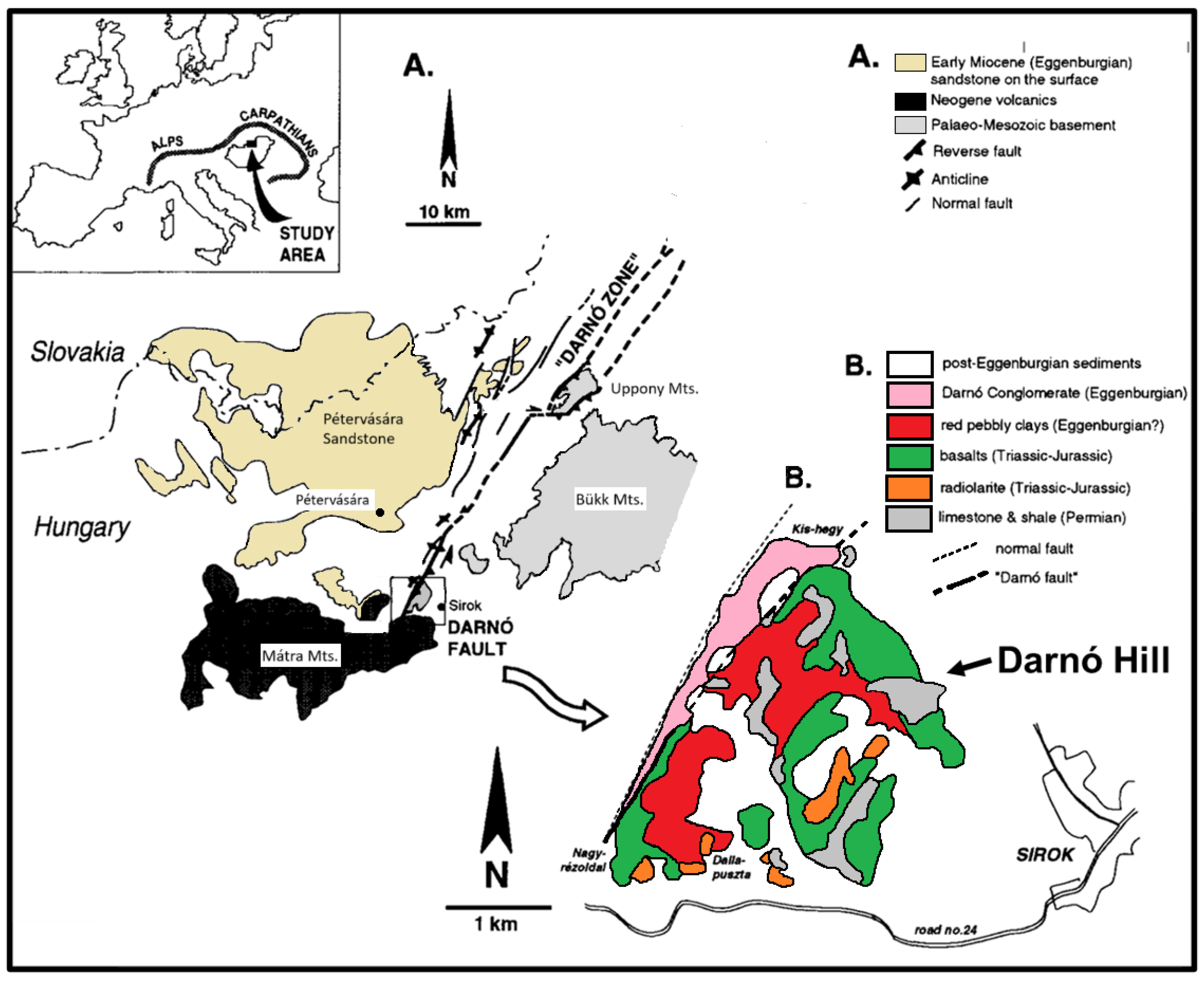

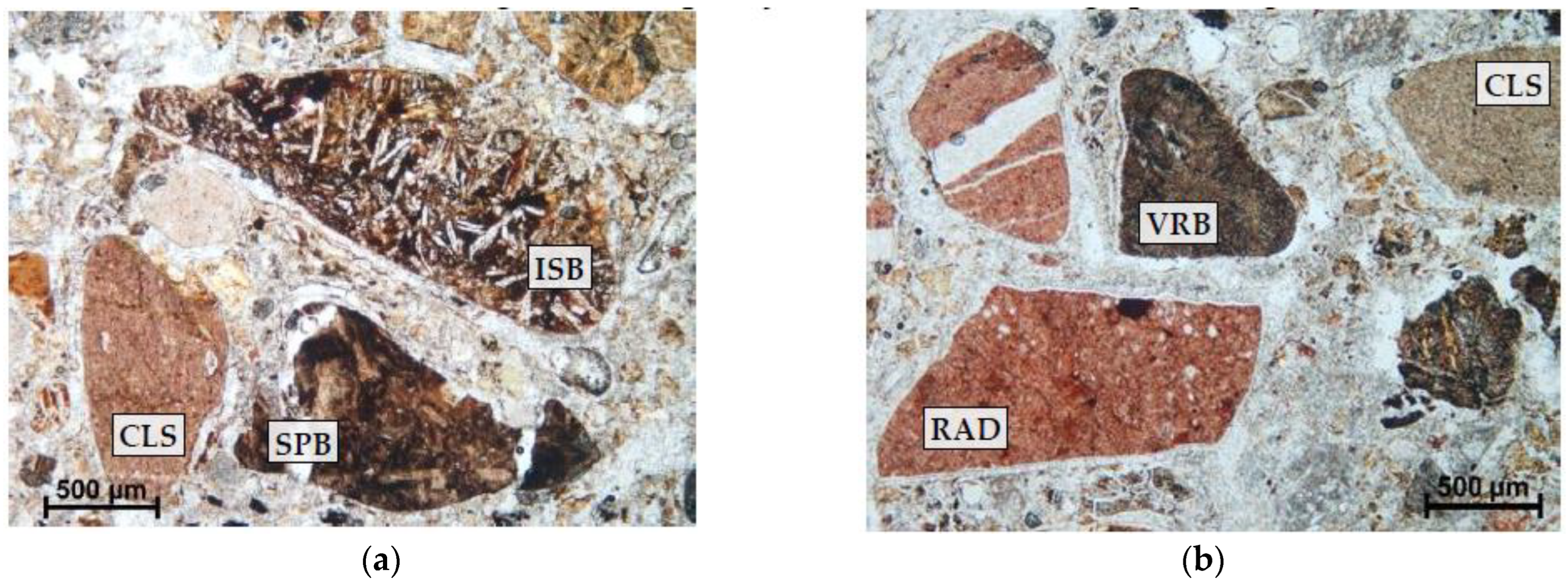
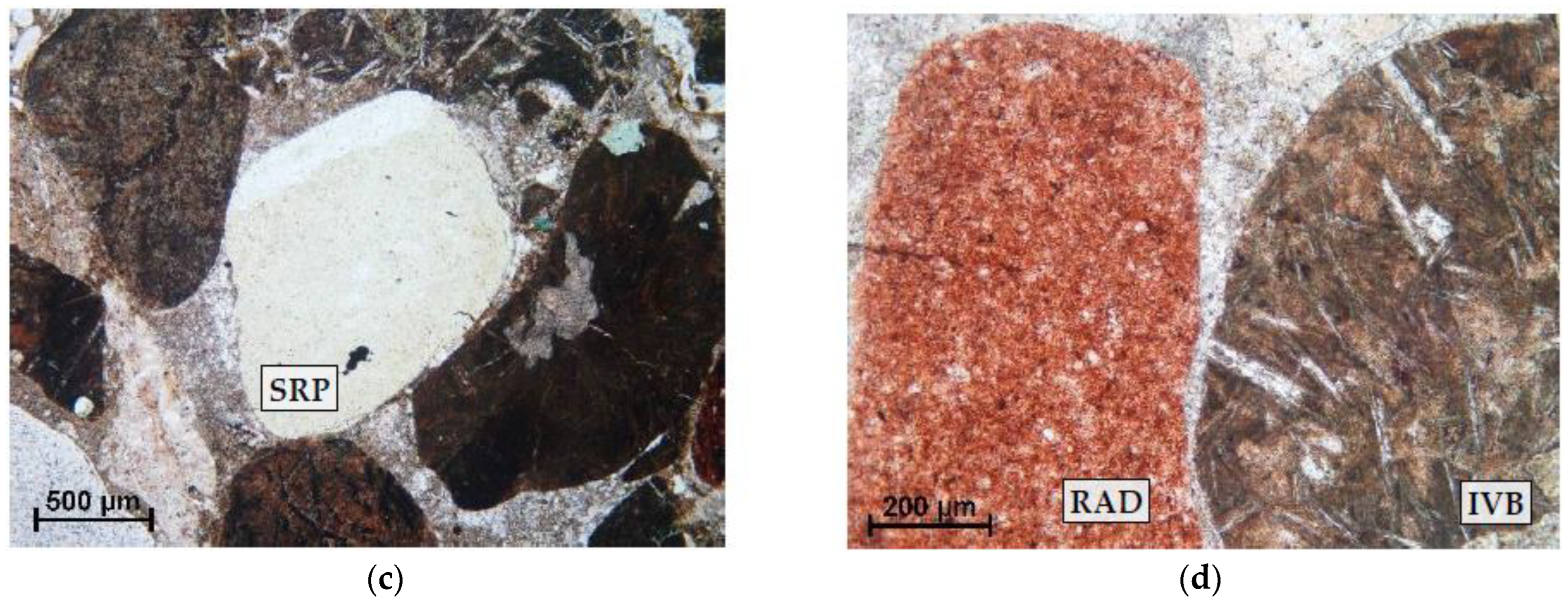

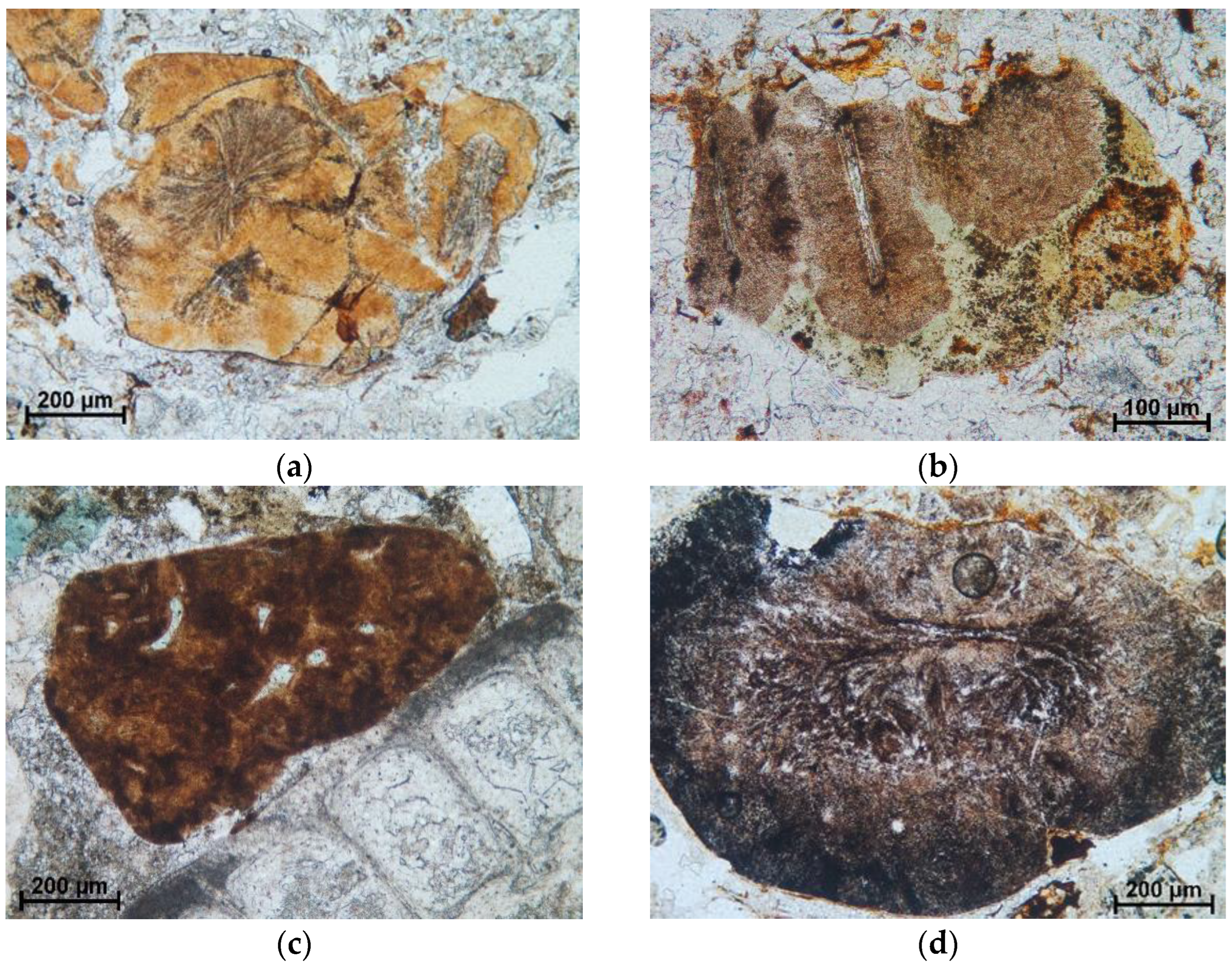
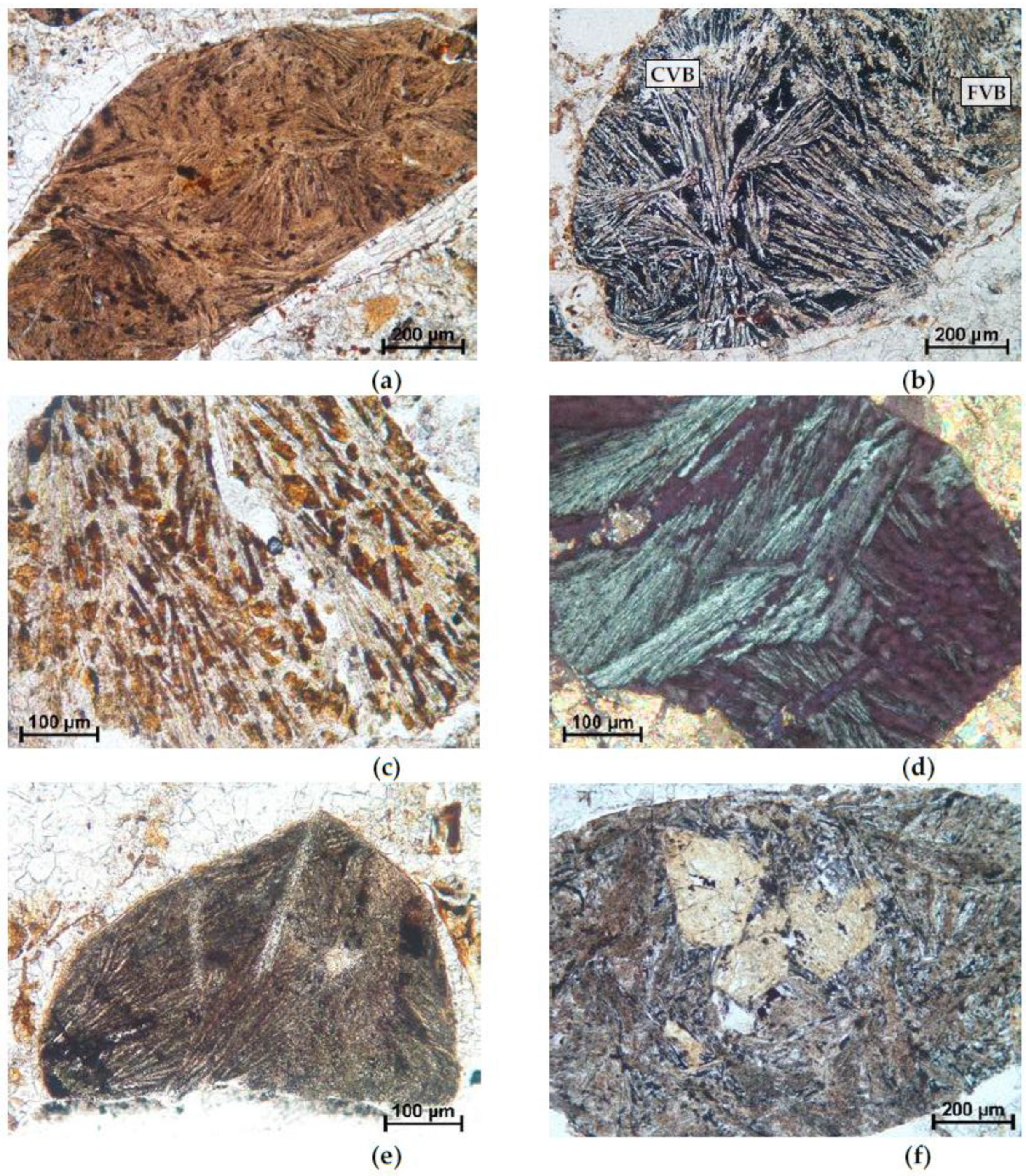
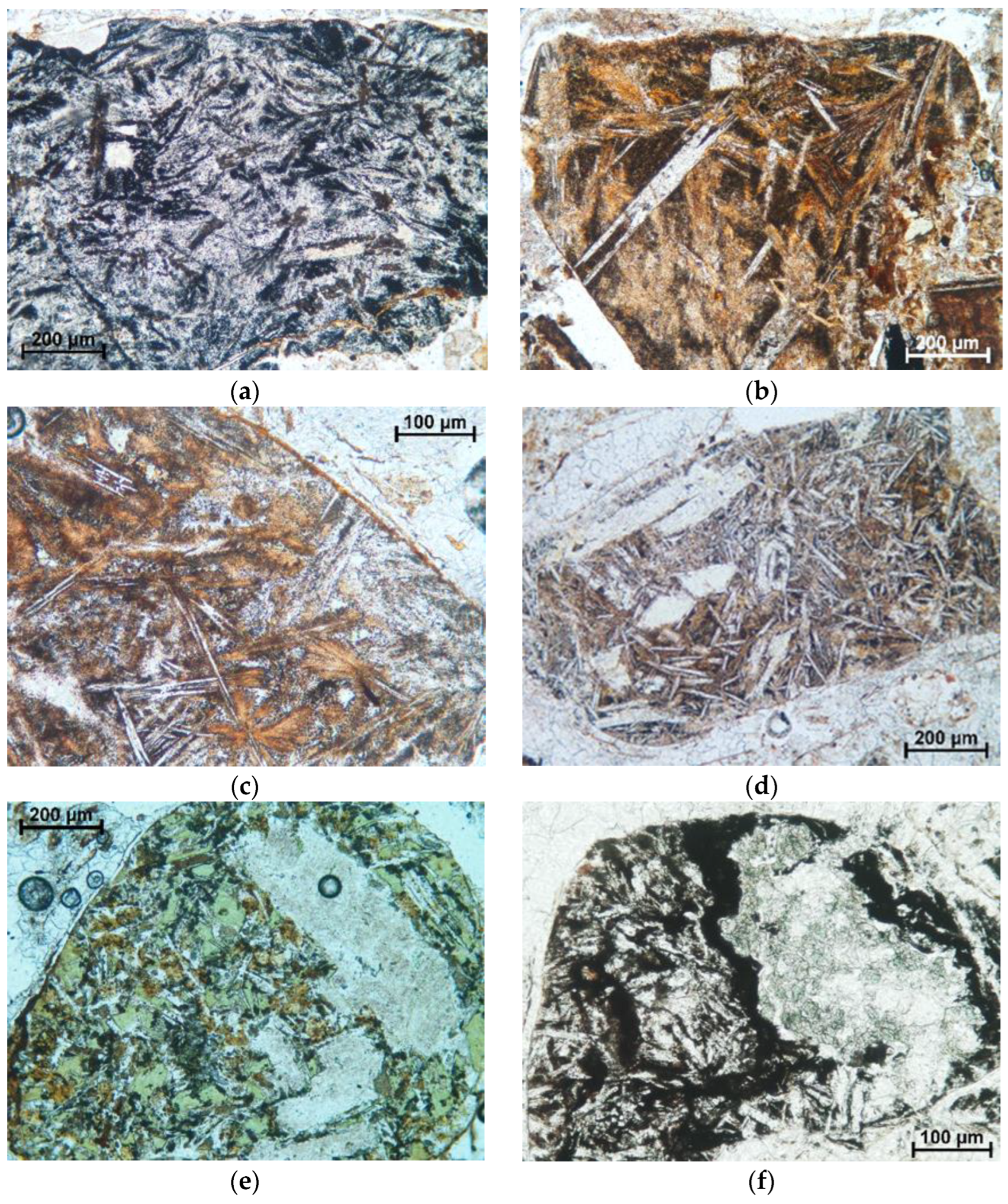

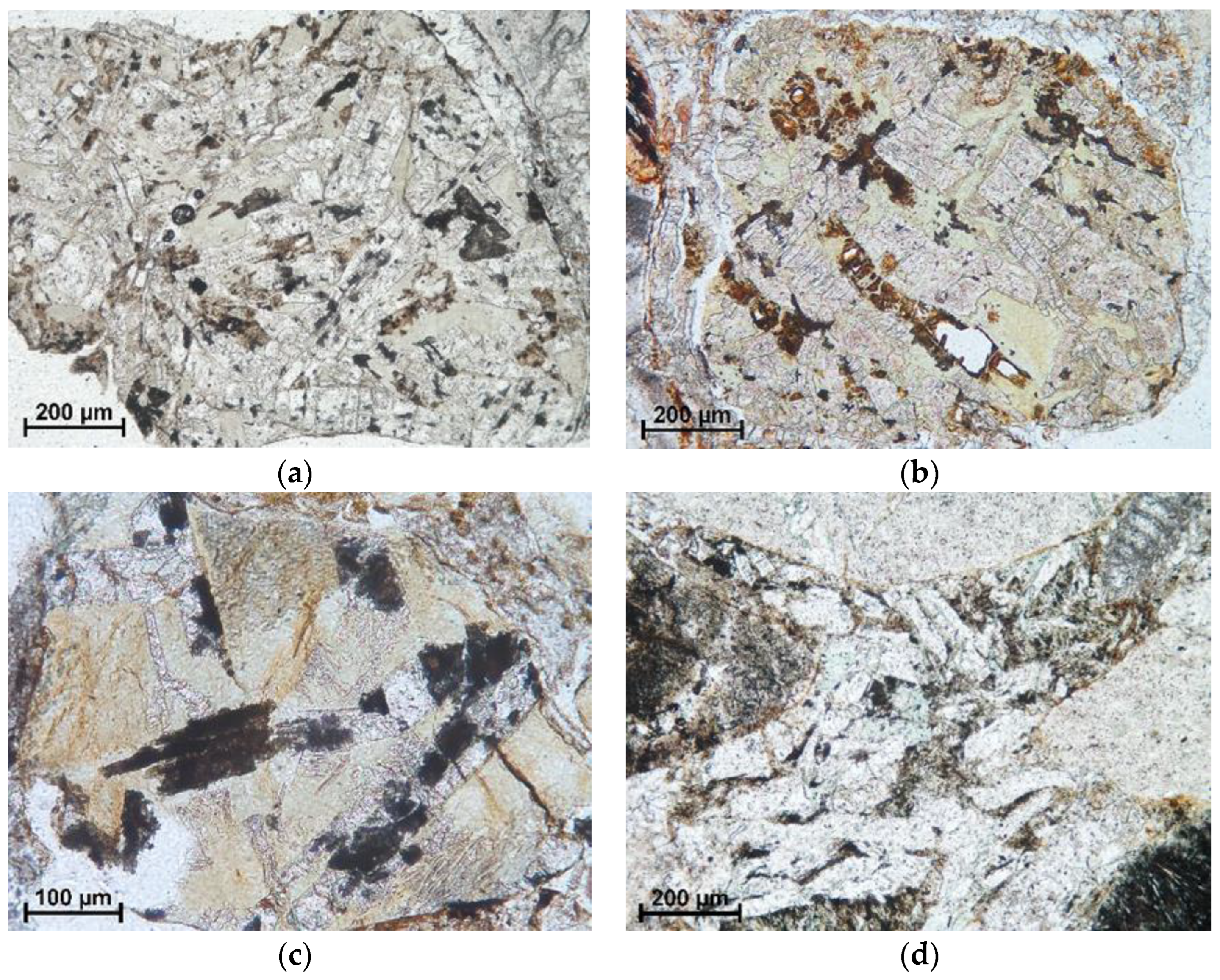
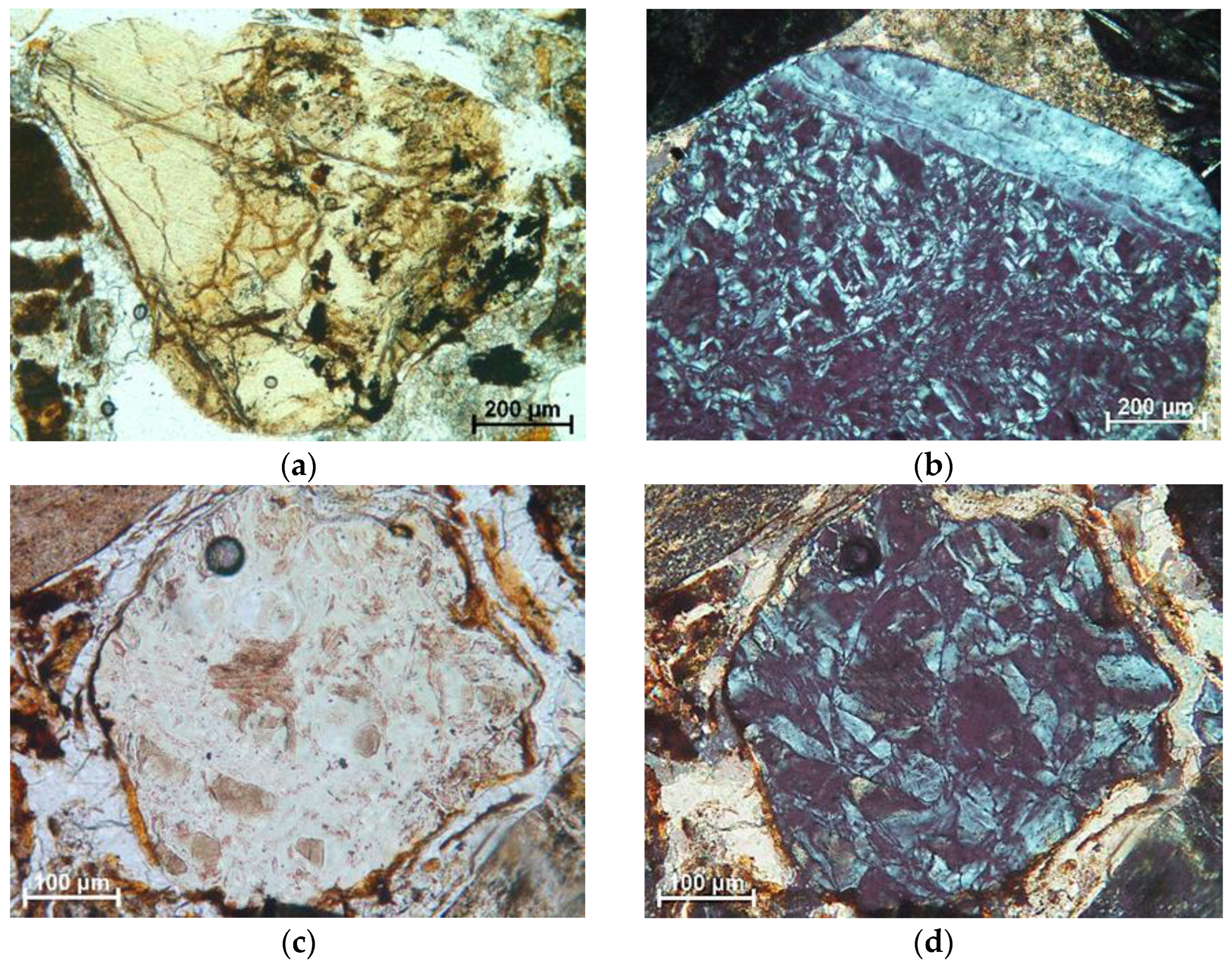


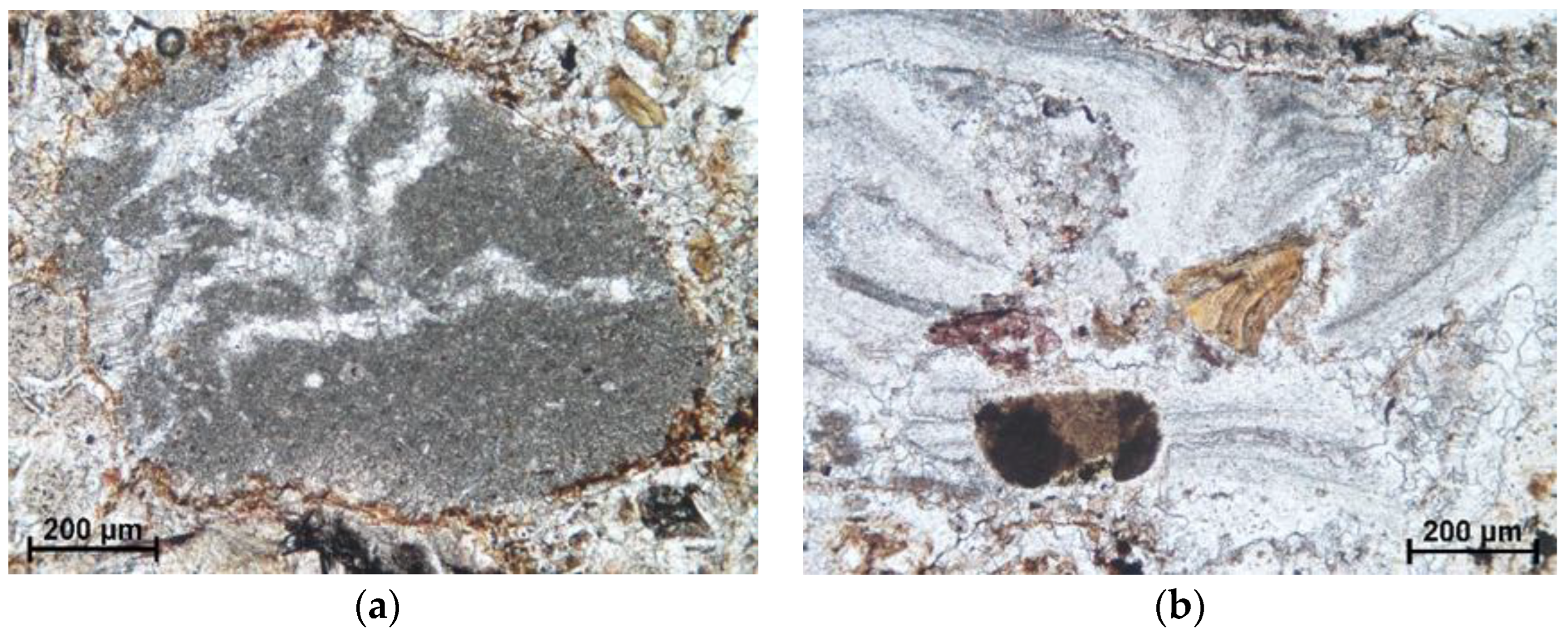
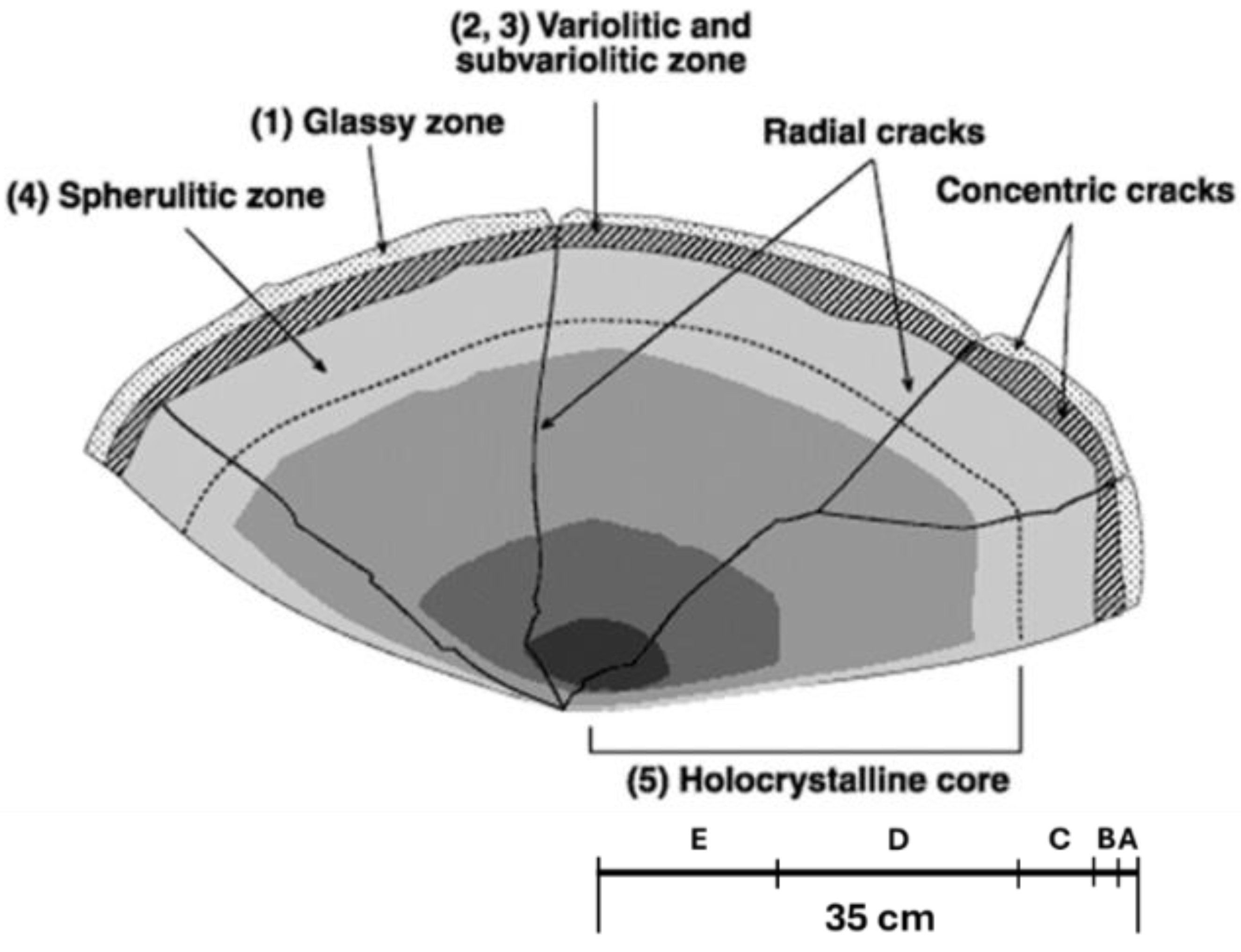
| Rock Type | Kis Hill-3 | Kis Hill-6 | Sum | Within All | Within Magm | Within Magm | Within Pillow | |||
|---|---|---|---|---|---|---|---|---|---|---|
| Grain No. | % | Grain No. | % | Grain No. | % | % | % | % | ||
| Magmatic rocks | Hyalinic basalt | 20 | 5.9 | 24 | 6.17 | 44 | 6.03 | 9.6 | 10.7 | |
| Spherulitic basalt | 30 | 8.8 | 21 | 5.40 | 51 | 6.99 | 11.2 | 12.4 | ||
| Variolitic basalt | 63 | 18.5 | 90 | 23.14 | 153 | 20.96 | 33.5 | 37.1 | ||
| Intersertal basalt | 51 | 15.0 | 62 | 15.94 | 113 | 15.48 | 24.7 | 27.4 | ||
| Intergranular basalt | 24 | 7.0 | 27 | 6.94 | 51 | 6.99 | 11.2 | 12.4 | ||
| Ophytic dolerite, microgabbro | 14 | 4.1 | 17 | 4.37 | 31 | 4.25 | 6.8 | |||
| Quartz, quartzite | 5 | 1.5 | 7 | 1.80 | 12 | 1.64 | 2.6 | |||
| Serpentinite, metaperidotite | 0 | 0 | 2 | 0,.51 | 2 | 0.27 | 0.4 | |||
| Sediment. | Claystone | 97 | 28.4 | 87 | 22.37 | 184 | 25.21 | 67.4 | ||
| siltstone, sandstone | 10 | 2.9 | 12 | 3.08 | 22 | 3.01 | 8.1 | |||
| Radiolarite | 19 | 5.6 | 30 | 7.71 | 49 | 6.71 | 17.9 | |||
| Limestone | 8 | 2.3 | 10 | 2.57 | 18 | 2.47 | 6.6 | |||
| All grains | 341 | 389 | 730 | |||||||
| Magmatic | 207 | 60.7 | 250 | 64.27 | 457 | 62.60 | ||||
| Sedimentary | 134 | 39.3 | 139 | 35.73 | 273 | 37.40 | ||||
| Pillow originated | 188 | 224 | 412 | |||||||
Disclaimer/Publisher’s Note: The statements, opinions and data contained in all publications are solely those of the individual author(s) and contributor(s) and not of MDPI and/or the editor(s). MDPI and/or the editor(s) disclaim responsibility for any injury to people or property resulting from any ideas, methods, instructions or products referred to in the content. |
© 2024 by the author. Licensee MDPI, Basel, Switzerland. This article is an open access article distributed under the terms and conditions of the Creative Commons Attribution (CC BY) license (https://creativecommons.org/licenses/by/4.0/).
Share and Cite
Józsa, S. Petrography of Ophiolitic Detritus from a Miocene Conglomerate Formation on Darnó Hill, SW Bükk Mts (N Hungary): A Unique Tool to Trace Covered Ophiolitic Sequences. Minerals 2024, 14, 983. https://doi.org/10.3390/min14100983
Józsa S. Petrography of Ophiolitic Detritus from a Miocene Conglomerate Formation on Darnó Hill, SW Bükk Mts (N Hungary): A Unique Tool to Trace Covered Ophiolitic Sequences. Minerals. 2024; 14(10):983. https://doi.org/10.3390/min14100983
Chicago/Turabian StyleJózsa, Sándor. 2024. "Petrography of Ophiolitic Detritus from a Miocene Conglomerate Formation on Darnó Hill, SW Bükk Mts (N Hungary): A Unique Tool to Trace Covered Ophiolitic Sequences" Minerals 14, no. 10: 983. https://doi.org/10.3390/min14100983






